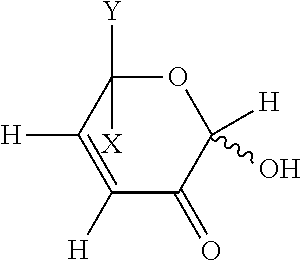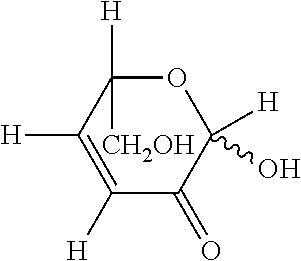Activity enhancer for detoxifying enzyme
a technology of activity enhancer and detoxifying enzyme, which is applied in the direction of anti-noxious agents, drug compositions, biocide, etc., can solve the problems of unfavorable components of the living body, and achieve the effects of promoting the detoxification process, reducing the risk of various diseases, and enhancing the activity of phase ii detoxifying enzyme or intracellular glutathione conten
- Summary
- Abstract
- Description
- Claims
- Application Information
AI Technical Summary
Benefits of technology
Problems solved by technology
Method used
Image
Examples
preparation example 1
Preparation of Agarobiose
[0067]Agar (AGAR NOBLE) was suspended in 0.1 N of HCl so as to have a concentration of 10%, and then heated at 100° C. for 19 minutes. To a Toyopearl HW40C (manufactured by TOSOH CORPORATION) column (4.4 cm×85 cm) equilibrated with water, 10 ml of the above sample was applied. Gel filtration chromatography was carried out using water as a mobile phase at a flow rate of 1.4 ml per minute. A substance eluted was detected with a differential refractometer, and 7 ml of fractions were collected.
[0068]There were peaks at elution times of 406 minutes, 435 minutes, 471 minutes and 524 minutes. A fraction corresponding to each peak was spotted onto a silica gel 60 sheet F254 (manufactured by Merck Co.), developed with 1 butanol:ethanol:water=5:5:1, and then analyzed by an orcinol-sulfuric acid method. As a result, it was found that the peak at 524 minutes was agarobiose. This fraction was freeze dried to obtain 140 mg of agarobiose.
preparation example 2
Preparation of L-glycero-1,5-epoxy-1αβ,6-dihydroxy-cis-hexa-3-en-2-one (DGE)
[0069]A suspension of 2.5 g of commercially available agar (AGAR NOBLE) in 50 ml of 0.1 N HCl was heated at 100° C. for 13 minutes to obtain a solution. The solution was cooled to room temperature, adjusted with NaOH to pH 12, and then neutralized.
[0070]The neutralized product was subjected to the following normal phase HPLC. Each peak was collected, dried under reduced pressure and then dissolved in water. A cancer cell growth suppressing activity of each fraction was measured using a HL-60 cell. It was found that a fraction at a retention time of 4.05 to 4.16 minutes had a cancer cell growth suppressing activity.
[0071]Then, the fraction at a retention time of 4.05 to 4.16 minutes was collected in large amounts, and subjected to structural analysis. As a result, it was found that the fraction was L-glycero-1,5-epoxy-1αβ, 6-dihydroxy-cis-hexa-3-en-2-one (DGE). Conditions used for the normal phase HPLC are sh...
example 1
Evaluation (1) of Enhancing Effect on Glutathione S-transferase (GST) Activity
[0072]Hepa1c1c7 cells (ATCC CRL-2026) were suspended in a Dulbecco-modified Eagle medium (manufactured by Sigma) containing 10% of fetal bovine serum (manufactured by MP Biomedicals Co.) and 1% of penicillin-streptomycin (manufactured by Nacalai Tesque, Inc.) at 4×105 cells / ml. To each well of a 96 well-microtiter plate, 0.2 ml of the cell suspension was added, and cultured at 37° C. overnight in the presence of 5% carbon dioxide gas. Then, the medium in the wells was replaced with a Dulbecco-modified Eagle medium. To each well, 0.4 μl of a solution of a test substance in water was added and then cultured for 24 hours. The agarobiose obtained in Preparation Example 1 and a commercially available agaro-oligosaccharide (trade name: Agaoligo, manufactured by Takara Bio Inc., containing agarobiose, agarotetraose, agarohexaose and agarooctaose in 20 to 25% each) were used as test substances. For a negative cont...
PUM
 Login to View More
Login to View More Abstract
Description
Claims
Application Information
 Login to View More
Login to View More - R&D
- Intellectual Property
- Life Sciences
- Materials
- Tech Scout
- Unparalleled Data Quality
- Higher Quality Content
- 60% Fewer Hallucinations
Browse by: Latest US Patents, China's latest patents, Technical Efficacy Thesaurus, Application Domain, Technology Topic, Popular Technical Reports.
© 2025 PatSnap. All rights reserved.Legal|Privacy policy|Modern Slavery Act Transparency Statement|Sitemap|About US| Contact US: help@patsnap.com



